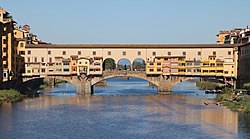Ponte Vecchio | |
|---|---|
 | |
| Coordinates | 43°46′05″N 11°15′11″E / 43.76799°N 11.25316°E |
| Crosses | Arno |
| Locale | Florence, Italy |
| Characteristics | |
| Design | Closed-spandrel segmental stone arch bridge |
| Longest span | 30 metres (98 ft) |
| Location | |
 | |
The Ponte Vecchio (Italian pronunciation: [ˈponte ˈvɛkkjo];[1] "Old Bridge")[2] is a medieval stone closed-spandrel segmental arch bridge over the Arno, in Florence, Italy. The only bridge in Florence spared from destruction during World War II, it is noted for the shops built along it; building shops on such bridges was once a common practice. Butchers, tanners, and farmers initially occupied the shops; the present tenants are jewellers, art dealers, and souvenir sellers.[3] The Ponte Vecchio's two neighbouring bridges are the Ponte Santa Trinita and the Ponte alle Grazie.
The bridge connects Via Por Santa Maria (Lungarno degli Acciaiuoli and Lungarno degli Archibusieri) to Via de' Guicciardini (Borgo San Jacopo and Via de' Bardi).
The name was given to what was the oldest Florentine bridge when the Ponte alla Carraia was built, then called Ponte Nuovo in contrast to the old one. Beyond the historical value, the bridge over time has played a central role in the city road system, starting from when it connected the Roman Florentia with the Via Cassia Nova commissioned by the emperor Hadrian in 123 AD.
In contemporary times, despite being closed to vehicular traffic, the bridge is crossed by a considerable pedestrian flow generated both by its fame and by the fact that it connects places of high tourist interest on the two banks of the river: Piazza del Duomo, Piazza della Signoria on one side with the area of Palazzo Pitti and Santo Spirito in the Oltrarno.
The bridge appears in the list drawn up in 1901 by the General Directorate of Antiquities and Fine Arts, as a monumental building to be considered national artistic heritage.
- ^ "Dizionario d'ortografia e di pronunzia" (in Italian). Rai. Retrieved 2010-02-24.
- ^ Ponte Vecchio. Encyclopædia Britannica. 2007.
- ^ Dupré, Judith (2017). Bridges: A History of the World's Most Spectacular Spans (Google Books). New York: Hachette/Black Dog & Leventhal. ISBN 978-0-316-47380-4. Retrieved 2 March 2020.